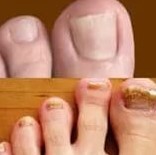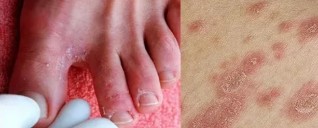A fungal infection of the toe nails are a common. There are a variety of different types of nail fungus and the treatment depends on the type of pathogen. The cause of the disease is the lack of hygiene, but many people have, in the course of the working day to be in your shoes.

The nature of the infection and the progression of the disease is in contact with fungal spores dead skin. The microorganisms penetrate into all the cracks, bumps, roughness, damage. In almost all cases the fungus passes through the nail, which is now starting to take on an unhealthy appearance.
Director
Itching, a change in the nail plate is a common symptoms that are recorded in all of its forms. There are a number of specific characters, depending on the type of pathogen. So, what types of fungus are there?
Dermatophyte
This form is developed at the contact with the pathogens Trichophyton, Microsporum, and Epidermophyton.
A man is faced with the following symptoms:
- the appearance of a gray, a yellow band on the cap. The first spots appear on a single nail, moving towards the close;
- the nail gradually starts to lag behind the bed.
The molding
The mold is in a position to influence, not only on the product but also your skin and nails. The main symptom of this form of fungal disease is a change in color.
With a healthy pink color, they become more unpleasant, in a black, brown, or green. Is not a less common symptom is the appearance of blackheads, spots.

Yeast
It occurs because of a fungus infection, Candida. A negative feature is the high probability of defeat the point. The main features include the following:
- The nail surface becomes much thinner, which makes them break down more quickly.
- Nail plate to change color, and structure.
- With the development of the disease there is a more powerful exfoliation.
- Fingers constantly swell and become red.
This infection is spread through moisture. For this reason, it is essential to follow certain preventive measures when you visit the swimming pools, and public shower.
Classification according to stage of development
To provide the most effective treatment, the physician has to determine what is the level of development it has reached a disease, it is proper to determine the stage of the fungus on the feet. With the development of the infection pathology is beginning to spread not only in the near the nails and on the skin, which have an influence on the entire leg.

Forms of the disease, on the basis of the stage of its development:
- Normotroficheskie, in which there is a change in the nail colour and the lines appear, but the form itself does not change. This is the initial stage of the infection.
- Hypertrophic, of which there is a change in the nails. He is very easy to break down, it becomes thin, with the enactment of the patient great inconvenience.
- Atrophic. The plate in this case is a lot thinner, it fades, the shape, the nail is bent, and is quickly destroyed. At this point, the nail plate begins to move away from the bed. The treatment here is quite severe, as the disease begins to take over the running form.
Relevant therapy for the
To get rid of the disease is possible only with the help of the therapy. It depends on the type of fungus, and it will have to be based on the stage of the disease.
The doctor carried out a medical expert examination, to determine the form and type of the fungus, the study of the individual characteristics of the organism and prescribe a treatment.
The selection circuit
Medicine offers three main treatment regimens – systemic, the holistic, and the treatment of outside resources. In the first case, it is assumed the dose of the medication in the form of tablets or capsules. A lot of them have a lot of side effects.
In the complex therapy for the treatment of not only tablets, but also for the local government. When the outside a minimum number of side-effects, and because of this, the color scheme is much better.
An essential point of thematic treatment that helps only in the initial stages of the disease, that is, if you are affected, less than one-third of the nail plate and no more than two fingers.

In the course of medical treatment at all levels and in all forms, is the basis of the various external treatment methods. We are talking about the creams, lacquers and solutions. The bows have an effect only on the nail fungus on the feet, without affecting the surrounding tissue.
Among the external means of treatment and is often used in a variety of creams. Not only are they effective to eliminate all pathological signs, but also to soften and moisturize the nail, the lowering of the indicators of discomfort. Regardless of the preferred method of treatment, the the the fungus, and the preparation is very important to follow the instructions of a specialist, and medications. The only way to achieve the positive results of the treatment. The only way of treatment you are provide an antifungal effect and an optimal antibacterial effect.
The number of applications, and the techniques used depend on the drug and the type of the mold, and the shape of its development. Usually, it is two to three times a day.
If you are using an external remedies for the treatment of the fungus before each application, it needs to be removed with special tools are keratinized. This will increase the penetrating ability of the drug to help much more quickly to achieve a positive effect, regardless of the type of fungus.
Summing up
The total duration of the treatment of the fungus, the average was 6 months, and then observed the growth of the health restored to the nail plate. To accomplish this result, the treatment is usually isn't the end, it has to be continued until the, as long as you don't reach a long-term effect and will not completely prevent the re-emergence of the disease.





























